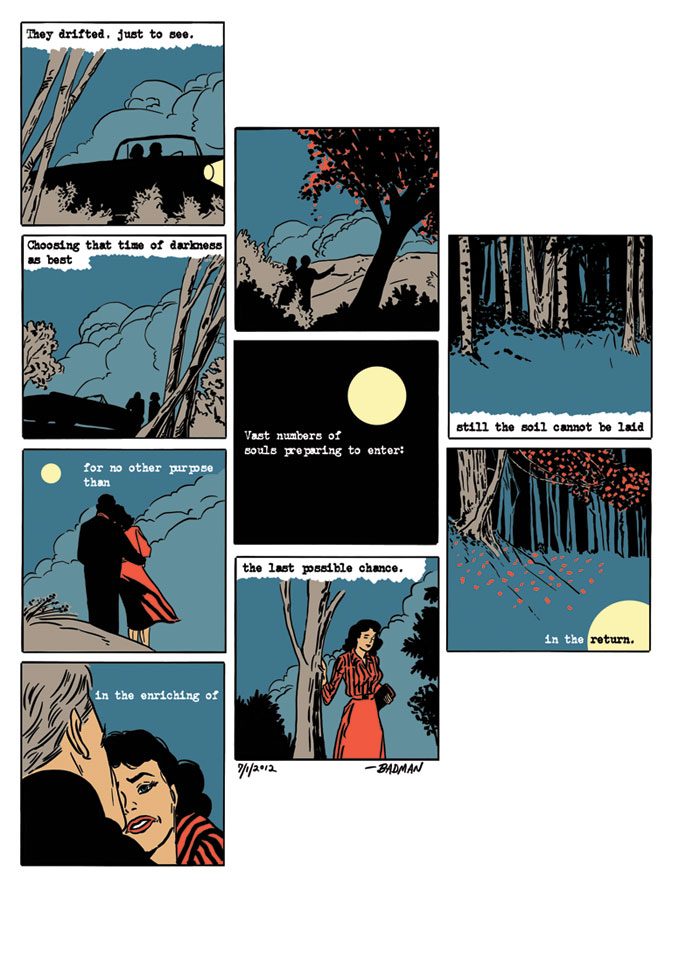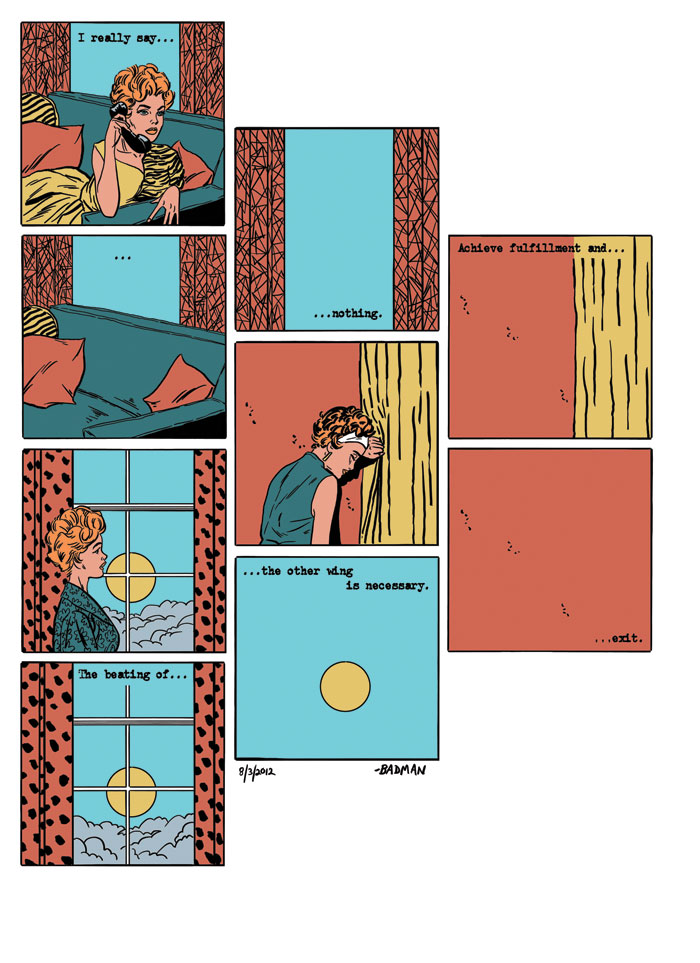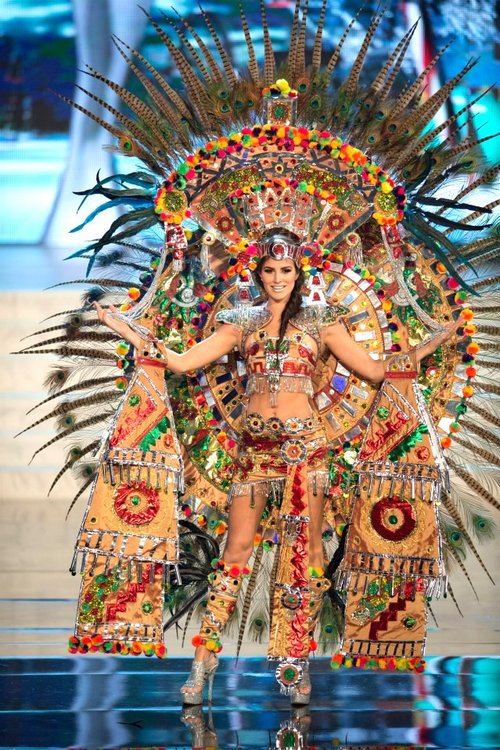Just wanted to mention that I’m friends with both Lilli and Derik, but somehow writing about their work here it seemed weird to use their first names. So I didn’t. Hopefully they won’t be offended!
_____________
A bit back I talked about Bart Beaty’s claim that comics have been culturally gendered feminine in relationship to high art. As I said in my post, I don’t find Beaty’s argument entirely convincing. In the first place, high art is itself often gendered feminine (and often mocked as such.) And, in the second place, after thinking about it more, it seems like comics are more often associated with children than with the feminine per se. Children are, of course, often associated with femininity themselves, since traditionally raising children is women’s work and also because anything not-man (whether it’s women, boy, girl, or a horror-film pile of undifferentiated slime) often gets lumped together as “feminine.” Still, it seems worth noting that comics’ femininity seems like its arrived at through a series of somewhat abstracted substitutions. In terms of culturally coded femininity, comics isn’t needlepoint.
Still, just because comics aren’t usually directly associated with femininity, that doesn’t mean that artists can’t treat comics as feminine, or play with the idea of comics as feminine.
For example, consider the short story “Kingdom” by Lilli Carré, included in her recent Fantagraphics collection Heads or Tails. The story starts off with a well-dressed fellow celebrating his expansive masculinity inside a high-art picture frame.

Page by page, though, new detailing and fringes are added to the inside of the frame, till the wide masculine range becomes a hemmed in, overly-crafted cozy feminine interior

And finally the man himself is reduced to a stylized decorative element. Instead of master of all he surveys, he is an object — or, rather, a surface, surveyed.

Again, the border here looks, and is surely intended to look, like a picture frame, and so the shuffling of gender is also a shuffling of the gendered connotations of fine art. On the one hand, high art is (as Beaty says) seen in its performative, striding creativity as a masculine kingdom — a canvas over which total control can be exercised in the interest of totalizing self-expression. At the same time, though, the detailed handwork and patterning associated with art — its prettiness, or fussiness, or surfaceness, or frivolousness — links it to the femininity of the craft fair.
If art is both hyperbolic masculine swagger and small-scale feminized detail, though, for Carré the form that mediates between the two is something that looks a lot like comics. The border in Carrés story is a frame…but, from page to page, it’s also a panel. So, on the one hand, the progression of the story could be seen as going from the least-decorated, most comic-like panel at the beginning to the most-decorated, least comic-like panel at the end — or, alternately, the initial image could be seen as a single picture frame, while the additional images emphasize more and more the sequential comic nature of the story. Thus, comics can be either a masculine form feminized by high-art frippery…or a feminine form which pulls high art down into the crafty feminine repetition of surface details.
Carréis herself a female artist who works in both the traditionally male-dominated art world and the traditionally male-dominated comics world. As such, she is, it seems, gently tweaking the masculine pretensions of both — or perhaps tweaking her own attraction to the masculine pretensions of both. That tweaking is performed in part by deploying comics as the feminine alternative to high art — and high art as the feminine alternative to comics. Both comics and high art, in other words, are only nervously, unstably masculine, and that instability is, for Carré, not so much a danger or a weakness as it is a potential — a way for masculine and feminine, art and comics, to open out and lock together in a single claustrophobic, vertiginous spiral.
Derik Badman takes a very different approach to comics as feminine. In the anthology Comics As Poetry, Badman channels pop art in a series of ambiguous pages.

Lichtenstein mostly used single panels drawn from comics for his canvases — he ironized melodramatic narratives by pulling single moments out of them, and so highlighting their generic artificiality. There’s a little of that in Badman’s version too; the off-kilter columns of images make the narrative flow uncertain — the panel sequence is almost arbitrary. You can read left to right or top to bottom, or even in some sense randomly around within the page.
Again, you could argue that the effect here is something like mockery and something like appropriation; taking the feminized tropes of romance comics, hollowing them out, and presenting the remains as a de-emotionalized, high-concept masculine avante garde. As I’ve written before, though,I think that reading does a disservice to Lichtenstein, and I think it’s not really fair to Badman either.
Rather, in Badman’s case, it seems less like the high art avant garde masculinizes the melodrama than like the melodrama reveals the true, feminized emotionalism of the avant garde. In the page below for example:

The first panel, with the telephone, becomes a kind of synechdoche for the entire page, thematizing an illustory connectedness which emphasizes a greater absence or distance. The ellipses trailing off or trailing in, to which panel or from which panel is never clear, similarly hesitantly underline the way each panel comes out of and goes into white space…comics not as Charles Hatfield’s art of tensions, but rather as an art of slack disconnection. The desire to make meaning of the narrative — to have “The beating of” connect to “the other wing” — is also the desire or loss of the woman — or perhaps of the women, plural, since the identity of multiple images is one of the comic conventions of continuity that here breaks down into the overarching convention of discontinuity. Comics multiplies bodies, and multiple bodies is desire. The avant garde lacunae, the resistance of interpretation, becomes, not anti-narrative cleanliness, but — through the mirror of comics’ formal elements — a hyperbolic extension of narrative’s most febrile excesses of deferment and longing.
Badman, then, seems to out-Beaty Beaty, inasmuch as, in this reading, comics is not just culturally feminized in relation to high art, but is actually, formally feminine. Indeed, that formal femininity is so overwhelming that it starts to absorb not just comics, but everything connected with comics — not least of all Pop Art. Badman’s comics almost demand to be viewed, not as cut up panels of comics, but as conglomerations of pop art images — and in creating those conglomerations, he makes it hard to see pop art as anything but conglomerations. Lichtenstein’s canvases…are they really isolating images from a narrative? Or, instead, are all those isolated images trying but failing but trying to talk to each other, so that all of Roy Lichtenstein’s panels end up, not as bits from different comics, but as their own single melodramatic discontinuity? For that matter, when you go to a gallery or a museum, each piece isolated in it’s own frame — doesn’t that isolation, that disconnection, that yearning gap, make the high art more comics than comics, and therefore, formally, more feminine than feminine?
For Badman, as for Carré, then, the binary art/comics doesn’t so much map onto the binary masculine/feminine as it creates an opportunity to think about binaries and gender. In the work of these two creators, comics and art want each other and want to be each other and want nothing to do with each other, and certainly too, are each other. So, too, does male/female close in upon itself and empty out of itself, a folding, unfolding box holding and releasing form and desire.









